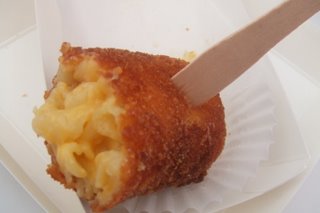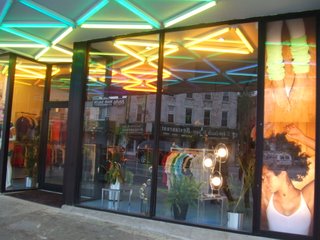
(AP) Shocked by the number of teens seeking breast implants, Botox injections and nose jobs, the leader of Australia's most populous state has said new laws are needed to make it harder for young people to go under the knife. -cbsnews.com
http://www.cbsnews.com/stories/2006/08/27/ap/health/mainD8JOL21G0.shtml
Plastic surgery is raging through female populations like a tempest. I am not so young that I can't imagine what it might be like to hit middle age and feel like you have no more control over your body's inevitable downward fall. I can see how that might be depressing and terrifying. I can see that if you had it in your power, you might make strides to stave off your body's throwing in of the towel at this point. But for a young girl with a face and a body that haven't even yet fully developed to turn to plastic surgery...and for her parents to give her the thumbs up sign on her way out the door...now that is beyond my comprehension, even if mom and dad have had some work done themselves.
Is attractiveness something that we feel we need to succeed in our world today, sort of like getting into a good college? According to a Newsweek article back in June 3, 1996, entitled
The Biology of Beauty, "Studies have shown that people considered attractive fare better with parents and teachers, make more friends and more money, and have better sex with more (and more beautiful) partners." All this research does is to validate what we already know about the importance of beauty in our culture.
The purpose of this email is not to be cynical and judgemental and to announce that a rise in plastic surgery amongst teens is further evidence that the world is falling to pieces. I don't want to believe that. But I keep thinking about the values driving this knife-work--- this desire for aesthetic perfection. Is this a new thing? Or, have we always wanted to have complete control over our appearance and now we just have more accessible tools to achieve this goal? Has attractiveness become more important for survival or is our culture just more open to talking about it? Do our faces represent just another means to self-improvement, a totally American concept, along with better-organized closets? When did what we look like become a problem to be fixed?
In my mind, there has been a shift in that there is a growing sense of consumer entitlement ("I deserve it!") paired with a growing comfortability with cosmetic procedures (probably enhancd by Hollywood glamour and the TV shows/media coverage).
Sure we hear in the Dove campaign that natural beauty comes from within, and Olay is telling us to love the skin we are in, but apparently not everyone is buying into these messages. Objectively, why should we buy into them if being more beautiful, by natural means or not, means having a better job, more sex and more friends? But what about self-confidence? Is the girl or guy with the big honker going to gain a newfound sense of self-esteem along with a brand new nose on their 16th birthday? Will they have nipped their insecurity issues in the bud at an early enough stage?
This rise in plastic surgery reflects a shifting notion of where beauty can come from and who gets to have access to it. In the old days, it was a genetic feat when someone came out looking beautiful; it was a chance left to nature and, I think, beauty was associated with superior genes. Nowadays, we are seeing the democratization of beauty. Access seems to take precedent over biology. If you can afford to buy it, you can have it. But, I ask, what are you going to do when your children come out looking like the old you? The proof is in the pudding.
Maybe plastic surgery is doing to the face what braces did to the teeth. I bet when braces were first introduced in the U.S., they represented both a horrific and an extravagant concept: semi-permanently affixing metal braces to teeth in order to slowly, painfully set them straight. Straight=symmetry=beauty (more on this below). Now braces are an American standard, and they have helped to "up" the beauty ante as well as to make Americans readily-identifiable within a larger global culture.
But braces do not fundamentally change people's appearance outside of their oral cavities. Your appearance is inherently linked to your identity- to your ethnic background, to your family's gene pool, to the things you have done in the time you have been on this earth. I know I am a Pulver because I have my dad's calves. I might not have picked these calves for myself if I had had a choice, but there they are, they are mine, and they have helped me through multiple marathons. My nose looks like it was hit dead-on with a lacrosse ball, because it was. My stomach is bloated because of my love for red wine (but my heart is healthy!). These aspects of my person make up my life story; the story of where I came from and what I have done with myself since. Hey- your physical self as evidence of your own personal life story. I like that! Much more interesting, and believable, than seeing "healthy"-looking, air-brushed women awkwardly parading around in white underwear (but feeling beautiful!) as part of the Dove campaign.
Last Spring I enrolled in a Graphic Design class at SVA. The teacher was a character and an excellent teacher. At one point he talked about imperfections and how they can make things more graphic and visuals more interesting (especially so in our hyper-polished, airbrushed media world). He told a story about a beautiful girl who was enrolled in one of his glasses. She usually wore her hair down, but one day she came in with her hair held back. The teacher saw that she has an enormous scar down the side of her face, which had previously been hidden by hair. He explained that at that moment she became even more beautiful to him and more interesting; there was a story behind that scar.
Rhodes and Tremewan (1996) conducted a study investigating averageness on attractiveness using a computerized generator to vary averageness. Their results indicate that averageness is attractive. Increasing the averageness of faces (anticaricaturing) and decreasing averageness (caricature) reduced attractiveness. Attractiveness and distinctiveness were negatively correlated. The less distinctive a face was, the more attractive it was. (http://clearinghouse.missouriwestern.edu/manuscripts/425.asp)
If plastic surgery truly hits the mainstream, will everyone start to look very symmetrical and similar? Is this what we are really looking for? What about our scars? Are scars and imperfections threatening and scary to people? What will happen to all of our visual life stories and how will their disappearance have an impact on what we find to be atractive, as well as the way that people relate to eachother? Everyone needs a way in...
And, according to the above-mentioned Newsweek article, "Studies have established that people everywhere--regardless of race, class or age--share a sense of what's attractive." The article goes on to state that "One key to physical attractiveness is symmetry; humans, like other species, show a strong preference for individuals whose right and left sides are well matched."
Will distinctive, physical traits become a thing of the genetic past? Is plastic surgery just fast-forwarding in the present what genetics is already taking on in the long term: weeding out imperfections and creating a human species with symmetrically-perfect bodies and faces? Or, is plastic surgery messing with the evolutionary process? It can create aesthetically-pleasing appearances, but in the process it erases any cues of genetic superiority and fertility. Essentially, it creates a mask.
Maybe plastic surgery is just another form of a peacock feather, helping humans to get together, feel sexy and mate. But, I am curious to see how it will all evolve....I don't have a study to back me up on this, I know from experience and observation that people gravitate towards what is different and seemingly exotic and rare. But this runs in contrast to the above-research that states people go for less distinctive when it comes to beauty. Could non-worked on people, people with faces that look natural but perhaps caricatured in contrast to worked-on faces, eventually become the new standard of beautiful? Maybe one day we'll get to see a girl with a scar down the side of her face on the cover of a magazine. Or will we continue to gravitate towards the air-brushed and familiar and essentially, to the non-threatening? Why would imperfections be threatening? Just a hunch, but I think that people are inherently made uncomfortable by people who aren't willing to apologize and don't worry about what other people think. And to me, changing your face and or body- through surgery or airbrushing- is the equivalent of making a permanent personal apology.
Lastly, if most people start "naturally" turning to plastic surgery, will overall attractiveness levels rise (as defined by symmetry and perfectly-aligned, non-distinctive features) and the value of beauty decline? Supply and demand theory in full effect? It seems to me that the beauty of beauty is that it was always a rarity. Something to be cherished, something special. If everyone seems to be beautiful and attractive, there will be no one worth looking at.


























